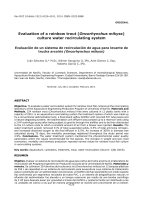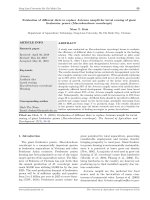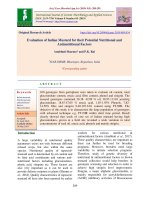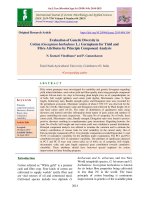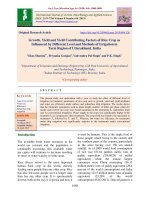Evaluation of drip irrigation system for okra crop under tarai condition of Uttarakhand, India
Bạn đang xem bản rút gọn của tài liệu. Xem và tải ngay bản đầy đủ của tài liệu tại đây (259.4 KB, 8 trang )
Int.J.Curr.Microbiol.App.Sci (2018) 7(3): 132-139
International Journal of Current Microbiology and Applied Sciences
ISSN: 2319-7706 Volume 7 Number 03 (2018)
Journal homepage:
Original Research Article
/>
Evaluation of Drip Irrigation System for Okra Crop under
Tarai Condition of Uttarakhand, India
Ravish Chandra1* and P.K. Singh2
1
Dr. Rajendra Prasad Central Agricultural University, Pusa, Samastipur-848125, India
2
G.B. Pant University of Agriculture and Technology, Pantnagar, Uttarakhand, India
*Corresponding author
ABSTRACT
Keywords
Distribution uniformity,
Christiansen’s uniformity
Coefficient, Wilcox and
Swails uniformity
coefficient and hart
uniformity coefficient
Article Info
Accepted:
04 February 2018
Available Online:
10 March 2018
Drip Irrigation Method is the best method that has been used in the world among the other
irrigation methods because of its good and high uniformity. This method distributes water
to the field using the pipe network and transforms it from the pipe network to the plant by
emitters. A field experiment was conducted at experimental farm of college of
Technology, G.B.P.U. A & T, Pantnagar, Uttarakhand to evaluate the performance of drip
irrigation system installed for okra crop. The different uniformity indicators were
Distribution uniformity, Christiansen’s uniformity coefficient (CUC), Wilcox and Swails
uniformity coefficient and Hart Uniformity coefficient. The performance of the drip
system under investigation can be categorised as good to excellent. The Distribution
Uniformity, Christiansen’s Uniformity Coefficient (CUC), Wilcox and Swails Uniformity
Coefficient and Hart Uniformity Coefficient ranged from, 89.8 to 96.7, 92.4 to 97.8, 90.9
to 97.2 and 92.8 to 97.8 respectively. The highest crop yield for okra crop was reported in
plot T1R3 (Drip irrigation based on 100% evaporation replenishment) which is having
higher Distribution Uniformity, Christiansen Uniformity Coefficient, Wilcox and Swails
Uniformity Coefficient and Hart Uniformity Coefficient values and lowest crop yield was
reported in plot T3R2 (Drip irrigation based on 60 % evaporation replenishment) having
lowest DU, CUC, UCW and UCH values. The result clearly indicated that increase in
irrigation uniformity increases the crop yield. Water production functions were developed
for okra crop considering irrigation depth and spatial uniformity of water application under
drip irrigation. The developed production functions can be used for predicting crop yield
for different depth of irrigation and uniformity.
Introduction
Drip irrigation is an artificial method of
supplying water to the roots of the plant. This
system is at times called trickle irrigation
system and includes trickling water onto the
soil at low rates (2-20 liters/hour) from an
arrangement of small measurement plastic
funnels fitted with outlets called emitters or
drippers. Drip Irrigation prevents soil erosion,
saves water and fertilizer can also supplied by
it. The high efficiency of drip irrigation results
from two primary factors. The first is that the
water soaks into the soil before it can
evaporate or run off. The second is that the
water is applied near plants so that only part of
the soil in which the roots develop is wetted,
not at all like surface and sprinkler irrigation,
132
Int.J.Curr.Microbiol.App.Sci (2018) 7(3): 132-139
which includes wetting the entire soil profile.
With drip irrigation system water, applications
are more frequent (generally every 1-3 days)
than with different techniques and this gives
great high dampness level in the soil in which
plants can flourish. Drip irrigation (also
known as trickle irrigation, micro-irrigation,
or low-volume irrigation) offers an excellent
alternative to sprinkler irrigation for vegetable
and small fruit growers. Trickle irrigation
systems typically use 30-50 percent less water
than sprinkler systems and the water are
rationed to the plants as they need it. This
reduces evaporation, grower to only water the
desired plants and not the row alleys or
roadways. Weed control is therefore
simplified, and workers are able to do
fieldwork while the irrigation system is
running. The system's almost continuous
operation at low flow rates and operating
pressures allow the grower to irrigate with
lower-cost, smaller pumps through smaller,
lightweight pipes which may deliver as little
as 15 or 20 m3/m.
Despite the success of drip irrigation systems
in India and several part of the world, variety
of problems related to optimal water and
fertilizer management still remain. The theory
behind trickle irrigation for conserving water
and fertilizer is sound, but the implementation
in the field may not always be practical. While
the method has great potential for high
irrigation efficiencies, poor system design,
management, or maintenance, can lead to low
efficiencies. In some instances the drip
irrigation systems were installed with little
concern for basic engineering hydraulic
principles and resulted in non-uniform emitter
discharge throughout the irrigated field.
Irrigators in order to overcome this lack of
uniformity found it necessary to over irrigate.
Over irrigation can lead to the wastage of
water, nutrients and energy as well as the
possibility of ground water contamination due
to excessive leaching. The crop yield is also
affected by the spatial uniformity of water
application. Keeping this in view the present
study was undertaken to investigate the
different uniformity indicators for drip
irrigation and response of drip irrigation
uniformity of water application on yield and
water production functions.
Materials and Methods
The experiments were conducted at the
experimental farm of the College of
Technology, GBPUA and T, Pantnagar, at
24°43ˊN latitude, 46°43ˊE longitude and 635
m altitude. The experimental site was irrigated
by a drip irrigation system. The field was
further divided into nine plots. Before the start
of the experiment, intact soil cores were
collected from different locations in the field
to determine soil physical properties including
soil mechanical analysis. Locations were
selected to represent the dominant soil
conditions in the field.
The experimental site consists of sandy clay
loam with sand (56 %), silt (16 %) and clay
(28 %). The average bulk density of the
experimental site was determined using core
sampler. The average bulk density was found
to be 1.50 g/cm3. Drip irrigation system was
installed for each plot. Buffer distances of
approximately 1 m separated the plots to
reduce environmental influences between
them. Drip system (DI) was equipped with
controllers to control the pressure and flow
meter to quantify the water added in each
irrigation event. Each plot was approximately
4m wide and 6 m long and had 8 rows of drip
lines spaced 0.5 m apart running from west to
east. The DI system consisted of 16 mm inside
diameter (I.D.) thin-wall drip lines with
welded-on emitters (GR, 50 cm dripper
spacing) with a nominal emitter discharge of 4
L/h at a design pressure of 200 kPa. Irrigation
amounts were metered separately in each
plant. The irrigation time varied between
133
Int.J.Curr.Microbiol.App.Sci (2018) 7(3): 132-139
treatments because of the three different
methods of irrigation scheduling used. The
hydraulic aspects of the design for drip system
aimed to obtain uniform application of
irrigation water. The water application
uniformity is a measure of how evenly the
volumes of water are applied from each
emitter. This uniformity was determined by
measuring emitter flow rates by measuring the
volume of water filled in a container in 30
minutes. To measure emitter flow rates,
graduated cylinder was used to measure the
volume collected for a given time of 30
minutes. A stop watch was used to measure
times. Altogether 15 samples were taken from
each experimental plot. A total of 135
measurements were taken from the nine plots.
The crop planted in the field was okra. The
variety of the crop was US 7109 F1 hybrid.
The treatment details of experiment are
presented below.
T1 - 100 % level of estimated crop water
requirement through drip irrigation
(1)
Where,
CUC = Uniformity coefficient percentage,
= absolute value of the mean deviation of
irrigation depth, and
= mean depth of
irrigation (Christiansen 1942). By substituting
emmiter flow rate qe for y, the uniformity for
trickle irrigation lateral lines can be estimated.
Distribution uniformity
Merriam and keller (1978) suggested a new
parameter
as
distribution
uniformity.
Distribution uniformity is expressed as a
percentage, and is a relative index of the
variability between emitters in an irrigation
block. Distribution uniformity is defined as
the average discharge of 25% of the sampled
emitters with the least discharge, divided by
the average discharge of all sampled emitters.
Wilcox- Swailes uniformity coefficient
T2 - 80% level of estimated crop water
requirement through drip irrigation
T3 - 60% level of estimated crop water
requirement through drip irrigation
The evaluations of water application
uniformity in this study were calculated with
the following methods. First, the uniformity of
water applied from the drip irrigation system
using discharge measurement data from
emitters and the following equations were
used to evaluate the drip system.
Christiansen uniformity coefficient
Christiansen’s uniformity coefficient (CUC) is
the most commonly used statistical method for
evaluating sprinkler system uniformity
(Warrick, 1983). Christiansen’s uniformity is
defined as:
The uniformity of sprinkler irrigation can also
be described using common statistical
parameters such as the coefficient of variation
(Vy) of the depth of irrigation water, y
(Wilcox – Swailes, 1947). The statistical
uniformity coefficient is defined as
) (2)
Where,
UCW = statistical uniformity coefficient as a
percentage, and Vy = coefficient of variation
of the depth of irrigation water, , or as the
previously defined the standard deviation (
over the mean . A similar statistical approach
can be developed for trickle irrigation systems
where the random variable y, the depth of
water in sprinkler irrigation is replaced by q so
134
Int.J.Curr.Microbiol.App.Sci (2018) 7(3): 132-139
that equation 3.13 becomes
(3)
Hawlin Sugar Planters Association- UCH
(Hart, 1961)
If the distribution in the field is normal, then
the absolute mean deviation from the mean is
equal to
. The Hart
proposes the following uniformity coefficient.
(4)
Results and Discussion
Despite the success of drip irrigation systems
in India and several part of the world, variety
of problems related to optimal water and
fertilizer management still remain. The theory
behind trickle irrigation for conserving water
and fertilizer is sound, but the implementation
in the field may not always be practical. While
the method has great potential for high
irrigation efficiencies, poor system design,
management, or maintenance, can lead to low
efficiencies. In some instances the drip
irrigation systems were installed with little
concern for basic engineering hydraulic
principles and resulted in non-uniform
emmiter discharge throughout the irrigated
field. Irrigators in order to overcome this lack
of uniformity found it necessary to over
irrigate. Over irrigation can lead to the
wastage of water, nutrients and energy as well
as the possibility of ground water
contamination due to excessive leaching. The
crop yield is also affected by the spatial
uniformity of water application. In order to
achieve this, the uniformity with which the
irrigation system applies water will have to be
high. The distribution uniformity of a system
has an effect on the system’s application
efficiency and on the crop yield (Letey et al.,
Solomon, Letey and Solomon). Irrigation
systems with poor distribution uniformity
experience reduced yields due to water stress
and/or water logging (Solomon and Clemmens
and Solomon. Poor distribution uniformity
also has increased financial and environmental
costs. Keeping this in view the present study
was undertaken to investigate the different
uniformity indicators and response of drip
irrigation uniformity of water application on
yield and water production functions.
Uniformity of water application
The uniformity evaluation results for the water
applied by the drip system were determined
and presented in Table 1. The parameters
relating to the performance of drip irrigation
system during the okra experiment are
presented in Table 1. The overall distribution
efficiency of the system ranged from 89.80 to
96.70 percent which can be categorised as
excellent since DU values were upto or equal
90 percent (Schuebach et al., 1999). The
highest distribution uniformity was obtained
in plot T2R1 (Drip irrigation based on 80 %
evaporation replenishment) while the lowest
value of distribution uniformity (DU) was
obtained in plot number T3R2 (Drip irrigation
based on 60 % evaporation replenishment).
The difference between the highest and lowest
distribution efficiency value was 7.6 percent.
The
overall
Christiansen
uniformity
coefficient (CUC) of the system ranged
between 92.36 to 97.85 percent which can be
categorised as an excellent. The highest
uniformity coefficient was obtained in plot
T2R1 (Drip irrigation based on 80 %
evaporation replenishment) while, the lowest
value was obtained in plot T3R2 (Drip
irrigation based on 60 % evaporation
replenishment). The difference between the
highest and lowest uniformity coefficient was
5.94 percent.
135
Int.J.Curr.Microbiol.App.Sci (2018) 7(3): 132-139
Table.1 Performance of irrigation system in terms of different uniformity
indicators during okra crop
Plot
no.
Crop
yield
(t/ha)
Depth of
irrigation
(mm)
T1R1
T1 R2
T1 R3
T2R1
T2 R2
T2 R3
T3R1
T3 R2
T3R3
9.80
10.71
11.41
9.90
10.06
11.22
8.19
7.55
8.13
361
361
361
291
291
291
222
222
222
Christiansen
uniformity
coefficient CUC
96.95
97.45
97.60
97.85
97.21
95.94
92.96
92.36
94.60
Distribution Wilcox and
uniformity Swails –
DU
UCW
96.20
95.80
96.30
96.70
96.50
94.40
93.40
89.80
92.40
94.90
95.34
96.19
97.20
96.45
92.86
94.48
90.86
92.77
Hart
Uniformity
coefficientUCH
95.97
96.33
96.99
97.79
97.19
94.36
95.64
92.79
94.29
Table.2 Crop water production function based on irrigation depth and uniformity for okra
S.N.
1.
Uniformity
Crop Water Production
Coefficient
Function
Christiansen
Y = 0.005 DI + 0.47 CUC – 36.4
Uniformity Coefficient Multiple R- 0.89
(CUC)
Standard Error-0.72
Y = 0.06 DI + 0.18 DU – 9.8
Multiple R- 0.86
Standard Error-0.82
2.
Distribution
Uniformity (DU)
3.
Wilcox and Swails
Y = 0.016 DI + 0.15 UCW – 9.1
Uniformity Coefficient Multiple R- 0.83
(UCW)
Standard Error-0.91
4.
Hart Uniformity
Coefficient (UCH)
Y = 0.016 DI + 0.19 UCH -13.1
Multiple R- 0.83
Standard Error-0.91
Wilcox and Swailes replaced the absolute
mean deviation from the mean, with the
standard deviation. Wilcox and Swailes
uniformity of the system ranged from 90.86 to
97.20 percent, which can be categorised as
excellent. The highest uniformity was
obtained in plot number T2R1 (Drip irrigation
based on 80 % evaporation replenishment)
Remark
Y = Crop yield
DI = Depth of irrigation, mm
CUC = Christiansen
uniformity coefficient, %
Y = Crop yield
DI = Depth of irrigation, mm
DU = Distribution uniformity,
%
Y = Crop yield
DI = Depth of irrigation, mm
UCW = Wilcox and Swails
uniformity coefficient, %
Y = Crop yield
DI = Depth of irrigation, mm
UCH = Hart uniformity
coefficient, %
while, the lowest value of distribution
uniformity (DU) was obtained in plot number
T3R2 (Drip irrigation based on 60 %
evaporation replenishment). The difference
between the highest and lowest Wilcox
Swails uniformity coefficient was 6.97
percent.
136
Int.J.Curr.Microbiol.App.Sci (2018) 7(3): 132-139
Hart uniformity coefficient of the system
ranged from 92.79 to 97.80, which can be
categorised as an excellent. The highest
uniformity was obtained in plot number T2R1
(Drip irrigation based on 80% evaporation
replenishment) while, the lowest value of
distribution uniformity (DU) was obtained in
plot number T3R2 (Drip irrigation based on
60% evaporation replenishment). The
difference between the highest and lowest
Wilcox Swails uniformity coefficient was
5.38 percent. The findings obtained in the
study was in agreement with the other
researchers (Camp et al., 1997, Al-Ghobari et
al., 2013 and Mistry et al., 2017)
UCW and UCH in treatment T3 may be due to
emitter plugging or due to manufacturing
variation among treatments (Manjunath et al.,
1998).
Crop water production functions based on
irrigation depth and uniformity
Water production functions have been
developed for okra crop considering irrigation
depth and spatial uniformity of water
application under drip irrigation. Crop water
production functions considering irrigation
depth and different uniformity coefficients for
okra is presented in Table 2. The multiple
regression equations were also developed for
okra crop considering crop yield as dependent
variable and depth of irrigation and
coefficient of uniformity as independent
variable. The important multiple regression
statistics such as multiple correlation
coefficient (Multiple R) and standard error
was obtained as 0.89 and 0.72 respectively.
In general, results indicated that the design
and management of an irrigation system are
not the only factors that influence water
uniformity above soil surface for any
irrigation system. Therefore, other factors
should be taking into consideration, such as,
the hydraulic gradients existing within the
unevenly wetted soil which influence water
movement laterally and perpendicularly
within the root zone
On the similar lines multiple regression
equation was also developed considering okra
crop yield as dependent variable and depth of
irrigation and distribution uniformity as
independent variable. The multiple regression
statistics such as multiple correlation
coefficient (Multiple R) and standard error
was found to be 0.86 and 0.82 respectively.
Yield as affected by depth of water applied
and uniformity
The highest crop yield for okra crop was
reported in plot T1R3 (Drip irrigation based on
100% evaporation replenishment) which is
having higher DU, CUC, UCW and UCH
values and lowest crop yield was reported in
plot T3R2 (Drip irrigation based on 60 %
evaporation replenishment) having lowest
DU, CUC, UCW and UCH values. The result
clearly indicates that increase in irrigation
uniformity increases the crop yield.
The empirical relation developed considering
okra crop yield as dependent parameter and
depth of irrigation and Wilcox and Swails
uniformity coefficients as independent
parameter is presented in Table 2. The
multiple regression statistics such as multiple
correlation coefficients was 0.83 and standard
error was 0.91.
The uniformity of water application from drip
irrigation system may have been affected by
water pressure distribution in the pipe
network and hydraulic properties of emitters
used. The relatively lower value of DU, CUC,
The crop water production function developed
considering okra crop yield as dependent
parameter and depth of irrigation and Hart
uniformity coefficient as independent
137
Int.J.Curr.Microbiol.App.Sci (2018) 7(3): 132-139
parameter is presented in Table 2. The
multiple regression statistics such as multiple
correlation coefficients was 0.83 and standard
error was 0.91.
useful guide to the potential performance of
the drip irrigation scheduling techniques.
The developed production functions can be
used for predicting crop yield for different
depth of irrigation and uniformity. The results
show that the optimum irrigation amount
depends on irrigation uniformity and on
agronomic and economic factors. Matovani et
al., (1995) found the similar results. For fixed
uniformity coefficient and uniformity, the
optimum amount of irrigation amount can be
determined.
Al-Ghobari, H. M. 2012. A comparison of
water application uniformity for drip
irrigation system above and below soil
surface at various soil depths and
scheduling techniques in arid region.
Transactions of Ecology and The
Environment. 68: pp311-321
Camp, C.R., Bauer, B.J., and Busscher, W.J.
1997. A comparison of uniformity
measures
for
drip
irrigation.
Transactions of the ASAE 40(4): pp.
1013–1020.
Clemmens A. J and Solomon K. H 1997.
Estimation
of
global
irrigation
distribution uniformity. J. Irrig. Drain.
Eng. 123 (6) pp. 454–461.
Hart W.E. 1961. Overhead irrigation pattern
parameters. Agric. Eng. 42(7):355–356.
Letey, 1985. Irrigation uniformity as related
to optimum crop production- Additional
research is needed. Irrig. Sci. (6) pp.
253–263.
Letey, J., Vaux, H. J. and Feinerman, N.
1984. Optimum crop water applications
as affected by uniformity of water
infiltration. Agron. J. 76: pp. 435–441.
Manjunath, M.V. 1998. Studies on testing and
applicability of microirrigation and
other irrigation systems in sweetlime
intercropping. Ph. D. Thesis, GBPUA,
Pantnagar, pp 273.
Mantovani, E.C., Vilalobus, F.J., Orgaz, F.
and Fereres, E. 1995. Modelling the
effects of sprinkler irrigation uniformity
on crop yield, Agriculture Water
Management, 27: 243-257.
Merriam, J. L. and Keller, J. 1978. Farm
irrigation system evaluation: a guide for
management. Utah State University,
Logan, UT, 271 pp. 255
References
The uniformity of water application is the key
in evaluation of drip irrigation system. The
performance of the drip irrigation system was
evaluated with the different standard
uniformity indicators of drip system. The
performance of the drip system under
investigation can be categorised as good to
excellent. The Distribution uniformity,
Christiansen’s uniformity coefficient (CUC),
Wilcox and Swails uniformity coefficient and
Hart Uniformity coefficient ranged from, 89.8
to 96.7, 92.4 to 97.8, 90.9 to 97.2 and 92.8 to
97.8 respectively. The highest crop yield for
okra crop was reported in plot T1R3 (Drip
irrigation based on 100% evaporation
replenishment) which is having higher DU,
CUC, UCW and UCH values and lowest crop
yield was reported in plot T3R2 (Drip
irrigation based on 60 % evaporation
replenishment) having lowest DU, CUC,
UCW and UCH values. The result clearly
indicates that increase in irrigation uniformity
increases the crop yield. Water production
functions were developed for okra crop
considering irrigation depth and spatial
uniformity of water application under drip
irrigation.
The
developed
production
functions can be used for predicting crop
yield for different depth of irrigation and
uniformity. The derived equation may provide
138
Int.J.Curr.Microbiol.App.Sci (2018) 7(3): 132-139
Mistry, P., Akil, M., Suryanaryana, T.M.V.
and Parekh, F. P. 2017. Evaluation of
drip irrigation system for different
operating
pressure.
International
Journal of Advance Engineering and
Research Development 2: pp 2348-4470
Schulbach, K., Tjosvold, S., Kasapligi, D.
1999. Improving irrigation system
conserves water in greenhouse grown
cut flowes. Calif. Agric., 53 (2): 44-48.
Solomon, K. H. 1983. Irrigation Uniformity
and Yield Theory. Ph.D. thesis, Utah
State University, Utah State University,
Logan, USA.
Solomon, K. H. 1984. Yield related
interpretations of irrigation uniformity
and efficiency measures. Irrig. Sci. (5)
pp. 161–172.
Solomon, K. H. 1990. Sprinkler irrigation
uniformity. [Internet]. Centre for
Irrigation Technology, California State
University, Fresno, USA. Available
from: < />publications /900803.html
Warrick, A.W. 1983. Interrelationships of
Irrigation Terms. Journal of Irrigation
and Drainage Engineering. 109(3):317332
Wilcox, J.C. and Swailes, G.E. 1947.
Uniformity of water distribution by
some undertree orchards sprinklers.
Scientific Agric. 27: 565-583
How to cite this article:
Ravish Chandra and Singh, P.K. 2018. Evaluation of Drip Irrigation System for Okra Crop
under Tarai Condition of Uttarakhand, India. Int.J.Curr.Microbiol.App.Sci. 7(03): 132-139.
doi: />
139



